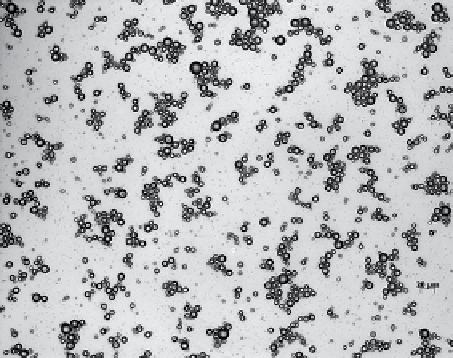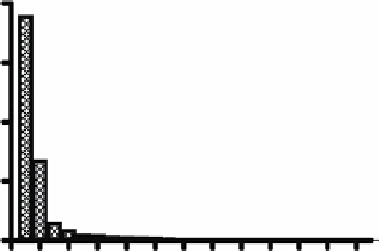Chemistry Reference
In-Depth Information
(a)
(b)
2000
1500
Mean diameter = 2.27 μm
1000
500
0
0246810
Diameter (μm)
12 14 16 18 20 22 24
fIgure 14.1
(a)
Representative light micrograph of SonoVue
®
microbubble suspensions. (b) Histogram showing diameter distribution
for a representative batch of SonoVue. The mean diameters of SonoVue microbubbles are 2.95 μm.
An ideal microbubble agent would have several essential characteristics:
• High echogenicity
• Inert
• Stable during bolus injection, infusion, cardiac and pulmonary passage
• Narrow size distribution
• Well-defined response toward incident US
Early versions of microbubbles were not optimised and yielded uneven sizes and poor stability. Advances in microbubble
stabilisation technology and preparation processes have enhanced its
in vivo
stability and improved its size distribution to a
certain extent [12-14]. To increase microbubble stability and persistence in the peripheral blood circulation, one can manip-
ulate the shell materials or filling gases. The shell materials stabilise the microbubble itself and reduce gas diffusion into the
surrounding blood. The shell can be stiff (denatured proteins or polymers) or flexible (phospholipids). Its thickness ranges
from 10 nm to 200 nm, with thinner shells typically used by protein and lipid microbubbles and thicker shells by polymeric
microbubbles [15]. on the other hand, low solubility and low diffusibility gases, including perfluorocarbons and sulphur
hexafluoride gas, have been found to enhance microbubble stability
in vivo
. The ideal filling gas should be inert and should
present a high vapour pressure and the lowest solubility in blood. A limited solubility in blood produces an elevated vapour
concentration in the microbubble relative to the surrounding blood and establishes an osmotic gradient that opposes the gas
diffusion out of the microbubble. Recent microbubbles combined both approaches to yield longer plasma half-life.
Gas-filled microbubbles can be classified into non-transpulmonary and transpulmonary types. Non-transpulmonary
microbubbles cannot pass through the lung, and are usually composed of air gas core. Transpulmonary microbubbles are


